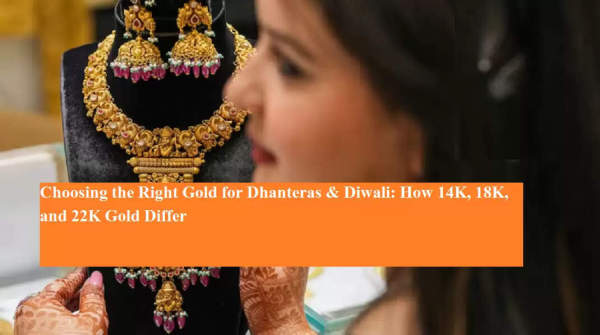
As Dhanteras and Diwali approach, gold jewelry stores across India are buzzing with shoppers eager to invest in the yellow metal. For generations, gold has held a special place in Indian households—not only as a symbol of prosperity but also as a trusted form of investment. With gold prices currently hovering above ₹1,26,000 per 10 grams for 24-carat purity, buyers are increasingly weighing their options between 14K, 18K, and 22K jewelry to suit their budgets and needs. But which type of gold should you choose, and what’s the real difference between them?
Before buying gold jewelry, it’s essential to understand what “karat” actually means. The purity of gold is measured in karats (K). Pure gold is 24 karats, meaning it contains 99.9% gold without any alloy mixed in. However, because 24K gold is very soft and bends easily, it isn’t suitable for making jewelry. Instead, it’s preferred for gold coins, bars, and investment purposes.
When metals like copper, silver, or zinc are added to gold, they make the metal harder and more durable—perfect for crafting intricate jewelry designs that can withstand daily wear. Depending on the proportion of these alloys, the karat value of gold decreases, but its strength and affordability increase.
In India, 22K gold is the most commonly used form for jewelry. It consists of about 91.6% pure gold, with the remaining 8.4% made up of other metals such as copper and silver. This blend enhances durability while retaining the rich luster that makes gold jewelry so desirable.
Because of its balance between purity and strength, 22K gold is ideal for crafting traditional jewelry like necklaces, bangles, earrings, and mangalsutras. It also offers a good resale value, which makes it a practical choice for those who view gold as both an adornment and an investment. However, its higher purity also means it’s more expensive compared to lower karat options.
If you’re drawn to modern, diamond-studded, or designer jewelry, then 18K gold might be the right pick. It contains 75% pure gold and 25% alloy metals, giving it extra strength while maintaining an elegant shine.
Because of its durability and ability to hold gemstones securely, 18K gold is widely used in making fine designer pieces, including engagement rings, earrings, and luxury bracelets. Additionally, since it costs less than 22K gold, it’s a budget-friendly option for those who prefer trendy designs without compromising on quality.
For people looking for durable jewelry suitable for daily use, 14K gold is a smart and economical choice. It contains around 58.5% pure gold mixed with metals like copper and nickel, giving it a firm structure and long-lasting strength.
While it may not shine as brightly as 22K or 18K gold, 14K gold is perfect for rings, chains, and bracelets that endure frequent wear and tear. Its affordability and resilience make it particularly popular among younger buyers and working professionals who want style without spending too much.
Regardless of which karat you choose, one rule remains non-negotiable—always check for the BIS Hallmark. This government certification ensures that your jewelry meets purity standards. The hallmark includes the BIS logo, purity in karats, and a unique identification number for the jeweler. It’s your guarantee against fraud, ensuring that you’re paying for authentic gold and not an inferior alloy.
As gold prices continue to rise, choosing the right type of gold depends on how you intend to use it. If you want something traditional with good resale value, go for 22K. For stylish or diamond jewelry, 18K is the ideal pick. And if you’re seeking affordable, daily-wear jewelry that’s strong and elegant, 14K offers the perfect balance.
This festive season, make your gold purchase not just a symbol of prosperity, but also a smart, informed investment. Whether it’s a gleaming necklace or a simple bracelet, choosing the right karat will ensure your jewelry remains timeless—both in beauty and value.